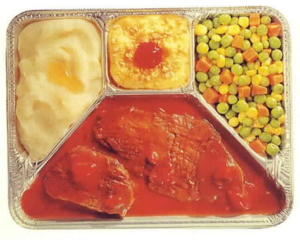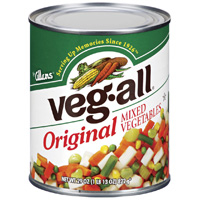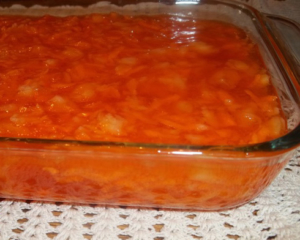My relationship with vegetables can best be described as tense. It’s not really my fault. I was raised in the southwest — places like Arizona and Oklahoma and Texas. If you’ve never been to Texas, it’s the country just north of Mexico and just south of the United States. Travel to Texas and you will realize that India is not the only place where cows are worshiped.
In Texas, the food pyramid is actually a straight line. At the top is beef. Below is everything else. In Texas, chicken counts as a vegetable.
In Texas, the food pyramid is actually a straight line. At the top is beef. Below is everything else. In Texas, chicken counts as a vegetable. In the rare case that a food dish in Texas isn’t beef, you can assume with near certainty that it contains some other form of meat. Probably several. I can’t prove it, but I harbor a deep suspicion that Texans put bacon grease in their coffee when no one is looking.
As far as I can tell, the rest of the South isn’t much different, except that the meat of choice in the deep South is pork, mostly because raising pigs doesn’t require a cowboy hat or a fancy belt buckle. In the South, the purpose of vegetables is to feed livestock so you can have more meat.
Southerners do make an exception for certain inedible plants like okra and rhubarb, which are fried in animal products or made into pies (or better yet, both). And corn, not being green, is permitted as long as you barbecue it on the same grill as the meat or make it into cornbread and use it as a topping for meat. But in general, there is no concept of a vegetable in Southern cuisine. If you’re eating Southern food and you run across something green, don’t eat it. Something was left in the fridge too long.
The 60s and 70s were a hazardous time to be a kid. In my neighborhood, there were only two forms of vegetables, frozen and canned. Frozen vegetables were generally limited to the teaspoon of corn or green beans added for decoration next to the apple sauce in frozen TV dinners. And mind you, these weren’t today’s cushy, plastic-plated, microwavable frozen dinners that actually resemble food. These were old school frozen dinners served in an aluminum foil tray that had to be heated for several days in an actual oven.

With old fashioned TV dinners, regardless of the picture on the box, the food had the same ashen gray color and wet cardboard consistency. When cooking was done, you had to dig the box back out of the trash to remind yourself what you were supposedly eating. Fortunately, because of the way they were packaged, vegetables in TV dinners were made more palatable by the fact that they invariable ended up mixed in with the desert.
But more typically, vegetables in my childhood came from cans. There were basically three varieties of canned vegetables — a sort of unholy triumvirate. The first was “Italian-style” zucchini packed in tomato juice. I had literally no idea what zucchini was. The picture on the can resembled neither the contents of the can nor anything else I had ever run across. It was just a slimy chunk of “not the main course” consumed under duress with a serving of “if you don’t eat everything on your plate you can’t have dessert.”
Second, there were green beans. Canned green beans are not green. But other than that, they at least vaguely resembled their real world counterpart. Unlike canned zucchini, which was truly vile, canned green beans had no particular flavor of their own. This was a distinct advantage. Put enough salt on them and they tasted like, well, salt.

The third canned vegetable, Veg-All, was sheer genius — the ultimate convenience food. Veg-All eased the burden of home cooks everywhere by eliminating the need to decide on which vegetable to serve. According to its maker, “Veg-All is a delightful blend of carrots, potatoes, celery, sweet peas, green beans, corn, and lima beans.” That’s right, the makers of Veg-All actually use “delightful” and “lima beans” in the same sentence. I can only assume they avoided prison by buying off the authorities with their ill-gotten gains.
In my household even canned vegetables weren’t served frequently. The only place I could always count on a vegetable was in Jello. Orange or red Jello meant shredded carrots. Green Jello meant Veg-All.

The sacrilege of putting vegetables in Jello is hard to overstate. By itself, Jello is the perfect food, an enticing blend of food color, artificial flavor and sugar. It has absolutely no nutritional value. Plus, you can play with it. And since it contains no actual substance, you’re never too full to eat it. It’s hard to imagine the kind of twisted depravity required to come up with an idea as inherently evil as putting vegetables in Jello. If I ever find the person responsible, I’m going to kick their ass.
As you might imagine, because of my upbringing, I am deeply uncomfortable with vegetables as a concept. Which is why — the universe having a notoriously perverse sense of humor — my youngest daughter came to me at age twelve and announced that she had decided to become a vegetarian. The conversation went something like this:
Daughter: I’ve decided to become a vegetarian.
Me: [silence]
Daughter: That means from now on I only eat vegetables.
Me: That’s okay, I have chicken…
Daughter: No, dad. V‑E-G-E-T-A-B-L-E‑S. No chicken. No beef. No pork. No fish. Just vegetables. And tofu.
Me: [pausing to wipe away tears] Tofu?
You must understand that I now live in northern California. It took a while, but I’m used to the idea of people subsisting on a diet of macrobiotic bean sprouts grown in organic soil composted with cat droppings and turned only by the natural scratching of free-range chickens that have been given actual names like “Astrid.” Well I’m used to it in theory. But it’s different when it’s your child.
I often lay awake at night wondering what went wrong. Did I drop her on her head as a baby? Should I have forced her to watch more football? Did someone slip her vegetables in grade school when I wasn’t looking?
It goes without saying that there is nothing in my background that emotionally equips me for having a vegetarian child. I often lay awake at night wondering what went wrong. Did I drop her on her head as a baby? Should I have forced her to watch more football? Did someone slip her vegetables in grade school when I wasn’t looking? How in the world did I end up with a child who forages for nuts and berries in my house like some primitive hunter/gatherer? (Well, technically, it would just be a “gatherer” in less you count “hunting” for the cheese in the back of the fridge.) I try my best, but I do not understand.
Still, I am a dutiful and devoted parent. Despite my upbringing, I have done my best to reconcile with vegetables for the sake of my daughter. At times, it has been a great sacrifice. As a carnivore and a male, one of the most humiliating days of my life was the day I walked into Safeway and had to ask directions to the tofu, where I painstakingly contemplated whether I should buy soft, firm or extra firm. For a father raised as a carnivore, there is no greater act of love than this. I hope my daughter remembers this when it comes time for her to choose my nursing home. She damn well better find one that doesn’t put vegetables in the Jello.
PS: Thanks to those of you who wanted to do an intervention. I appreciate your concern. No need. I actually eat a (relatively) healthy diet and you should too. Also, no Whole Foods shoppers were harmed during the writing this piece. At least I don’t think they were.

What a great story Rob! Love how you pull your childhood memories of veggies in…especially those jello salads!
Thanks Becki. I might have to make a jello salad for old time’s sake.
Sounds like a song at Riverfest!
A SONG! What a great idea.
Maslak su kaçağı tespiti Kadıköy’deki ofisime su kaçağı tespiti için çağırdım, sonuç çok hızlıydı. http://www.marevidapescados.com/?p=1896
Beyoğlu su kaçağı tespit cihazı Esenler’de su kaçağı tespiti yaptırdım, başarılı bir sonuç aldım. Kesinlikle tavsiye ediyorum. https://pmrczambia.com/uskudar-su-tesisat-tuvalet-acma/
Kuruçeşme su kaçağı tespiti Evimi Kırmadan Sorunu Çözdüler: Kırmadan su kaçağı tespiti hizmeti almak çok büyük bir kolaylık. Banyomuzda hiçbir yeri kırmadan problemi buldular. https://myprint-bonn.de/?p=4781
http://atora.ru/blogs/interesnye-statyi/foo-fighters-energiya-roka-i-dukh-nezavisimosti1.php
https://vitz.ru/forums/index.php?autocom=gallery&req=si&img=4975
https://honda-fit.ru/forums/index.php?autocom=gallery&req=si&img=7216
Good https://is.gd/tpjNyL
Very good https://is.gd/tpjNyL